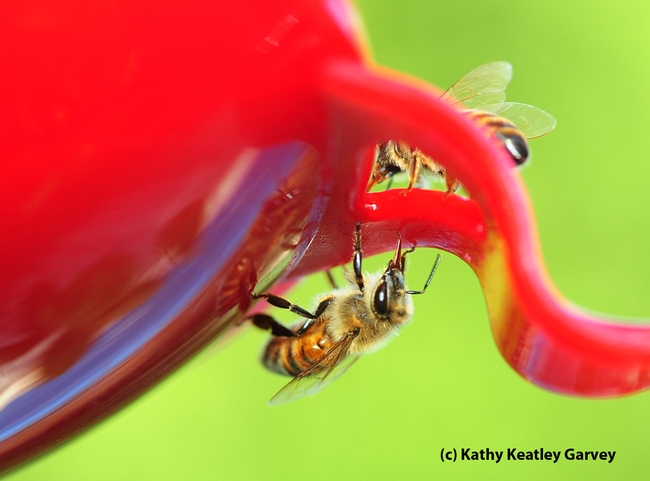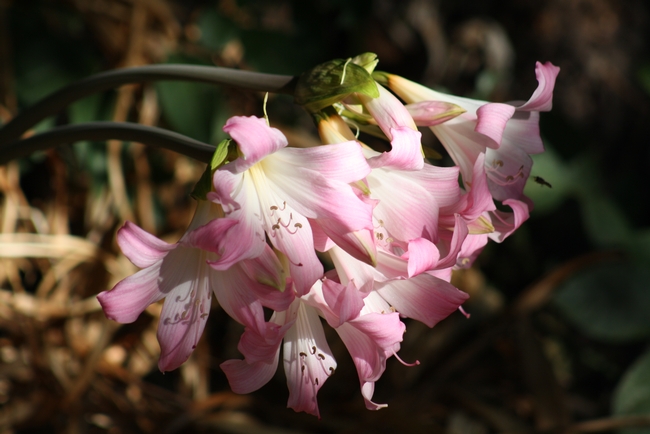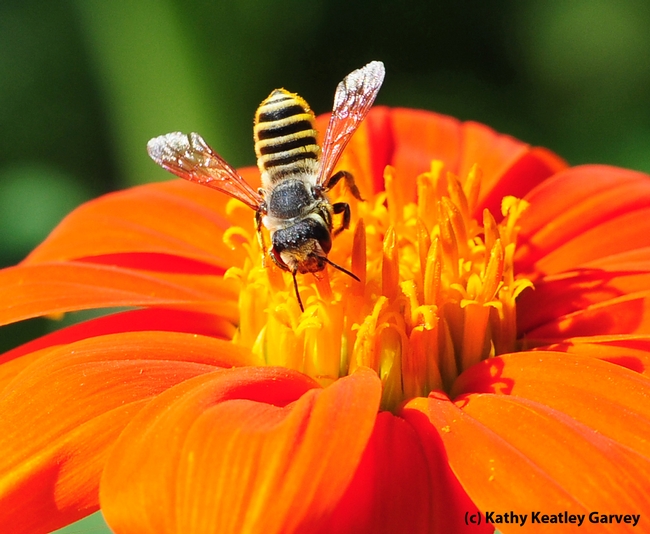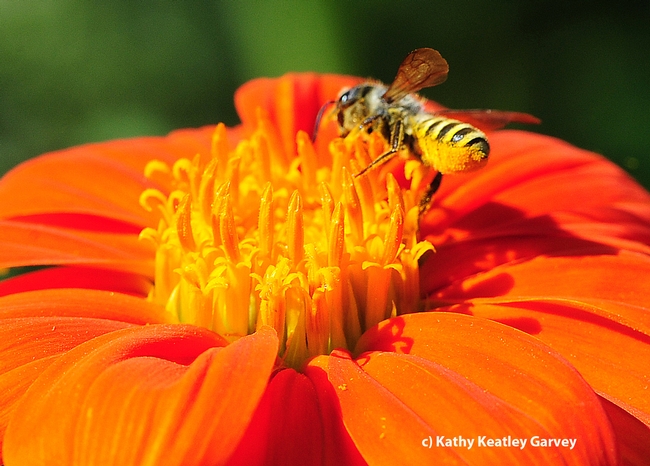UC Blogs
Dining Where They're Not Wanted
If your hummingbird feeders are filled with that oh-so-tantalizing sweet sugary syrup, you may be attracting not only hummers, but honey bees, too....

Honey bees licking the surface of a hummingbird feeder. (Photo by Kathy Keatley Garvey)

Hummers can reach this syrup but the bees cannot. (Photo by Kathy Keatley Garvey)
UCCE takes part in obesity prevention task force
A group of about 40 San Joaquin County professionals meet regularly to share ideas and strategies for combating obesity and overweight, afflictions that effect the majority of the county's residents, according to an article in the Stockton Record.
UC Cooperative Extension advisor Anna Martin is the interim facilitator of the Obesity and Chronic Disease Prevention Task Force, which first convened in August 2009. Other members of the task force represent health and human services agencies, hospitals, school districts, the County Office of Education, University of the Pacific, health insurers, collaboratives such as Healthy San Joaquin and Select San Joaquin, the regional air district, nonprofit agencies such as Community Partnership for Families of San Joaquin and Women, Infants and Children programs.
A recent meeting featured guest speaker Genoveva Islas-Hooker with the Fresno-based Central California Regional Obesity Prevention Program.
She said that in many of the targeted neighborhoods where the obesity-prevention program is active, primarily in unincorporated rural areas, people cannot drink the water and have to turn to processed beverages.
"A 20-ounce bottle of water is $1.99 versus a 44-ounce sugar drink that costs 79 cents. We need to stop pushing soda consumption," she said.

Inexpensive soda contributes to the obesity epidemic, experts say.
The Ladies Are Almost Here!
I'm referring to the sweet, pink Amaryllis belladonna bulbs in my garden, also commonly referred to as "Naked Ladies." In case you're not familiar, they are the stalk topped by several clusters of pink trumpet-shaped flowers. What makes them so striking are the naked stalks with no leaves, just flowers, thus the nickname "Naked Ladies."
I love that they have a lovely fragrance. It's also nice to know that they do just as beautifully in our hot Mediterranean climate as they do on the foggy, cool northern California coast . As long as they are treated to warm, dry summers in well-drained soil, they'll do well for you for a very long time.
My first batch of these bulbs (about 5 bulbs) were given to me about 14 years ago in a brown paper bag by my Uncle Bob. He passed away several years ago, and his wife, my aunt, just recently went on to be with him, so this years bloom is bittersweet to see. Anyway, in the years since, I've divided the bulbs a few times (they don't appreciate being disturbed, especially at the wrong time), so that now I have these little beauties popping up all over my backyard. They are a gift that keeps on giving, year after year.

The Naked Ladies. (photo by Jennifer Baumbach)
The Midsummer Garden Tune-Up
I was talking with a few fellow gardeners recently and was asked for some suggestions on what gardeners can do to keep our garden space looking its best and in the best health during the taxing, hot, summer months. The first and maybe most important thing a gardener can do in mid-summer is to mulch the beds of the garden so that moisture levels are maintained in the soil during long hot days. This will prevent some of the extra watering the garden often needs of those 90+ degree days. In addition to adding mulch I also add compost to my flower and vegetable gardens to get some fresh nutrients to the plants which are often overdue to be replenished. Most of us compost the garden in early spring and after a few months all of the beneficial nutrients have been used up and need to be replaced. It is especially important for vegetables so that they have plenty of nutrients to complete bearing mature fruit. This is also a good time to stake the larger vegetable plants for reinforcement and continued healthy production. The vegetable plants will likely increase in size after the composting has been re-done and staking the plants in advance will enable continued plant growth. The middle of summer is an opportune time to dead head old blooms and make room for fresh new ones to begin developing. It is a little detail that makes a big difference if you have lost some color in your flower garden. Finally, this time of year is a great time to weed the garden carefully, remove the unwanted weeds and make some space for your favorite plants to stretch out and fill in.
Piling on the Pollen
It's a native bee. It's a pollinator. And it's a leafcutter. This morning we admired this female leafcutter bee, Megachile fidelis, as identified...

Female leafcutting bee, Megachile fidelis, foraging on a Mexican sunflower. (Photo by Kathy Keatley Garvey)

Note "the brush of hairs on the underside of her abdomen where she is packing pollen for the trip back to her nest," says native pollinator specialist Robbin Thorp. (Photo by Kathy Keatley Garvey)

This female leafcutting bee, Megachile fidelis, is loaded with pollen. (Photo by Kathy Keatley Garvey)

